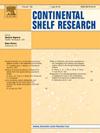波罗的海碱度增加:一个插曲还是一个新的稳定状态的发展?
IF 2.2
3区 地球科学
Q2 OCEANOGRAPHY
引用次数: 0
摘要
波罗的海咸淡水的碱度是海洋贡献和河流及内部来源的贡献的产物。这个非海洋部分(ATfresh)可以通过从测量的AT中减去与盐度相关的海洋AT,并将结果除以淡水部分来量化。ATfresh=(AT−AToc * SSoc)/(1−SSoc),其中Soc为海水的盐度,AToc为海水的AT。因此,ATfresh是波罗的海淡水部分中AT的浓度。使用ATfresh有助于简化和透明的AT数据统计处理和直接的预算计算。此外,ATfresh的趋势直接反映了河水和/或内源的AT输入的变化。1995-2024年间,向北大西洋过渡的一个站和波罗的海地区的两个站的每月地表水AT数据(瑞典国家监测计划,SMHI)没有显示出连续的ATfresh趋势,但其特征是在2004-2016/17年期间出现了临时的ATfresh增加。在波罗的海中部,ATfresh的增加速率为7.4 (μmol/kg)/yr,而在盐度为7.1时,AT的增加速率为5.8 (μmol/kg)/yr。临时趋势结束后的有限的ATfresh数据无法得出导致趋势的原因的结论,这可能是暂时有限的atr输入事件或现有永久atr源的增加。在后一种情况下,ATfresh的过渡趋势代表在较高的ATfresh水平上向新的稳定状态过渡。2009年至2024年期间波黑湾的最新数据显示,在测量期中期出现了明显的最小值,但没有总体趋势的证据。我们的研究表明,波黑湾的这种ATfresh模式是由于与波罗的海固有海域的水交换导致的ATfresh输入的变化,这主要控制了波黑湾ATfresh的丰度和趋势(72%)。本文章由计算机程序翻译,如有差异,请以英文原文为准。
Alkalinity increase in the Baltic Sea: An episode or the development of a new steady state?
The alkalinity (AT) of the brackish water in the Baltic Sea is the product of an oceanic contribution and a contribution comprising inputs from rivers and internal sources. This non-oceanic fraction (ATfresh) can be quantified by subtracting the salinity dependent oceanic AT from the measured AT and dividing the result by the freshwater fraction.
, where Soc is the salinity and AToc the AT of inflowing ocean water. ATfresh is thus the concentration of AT in the freshwater fraction of the Baltic Sea. The use of ATfresh facilitates a simplified and transparent statistical treatment of AT data and straightforward budget calculations. Furthermore, trends in ATfresh directly reflect changes in AT inputs by river water and/or internal sources.
The monthly surface water AT data (Swedish National Monitoring Programme, SMHI) during 1995–2024 at a station in the transition to the North Atlantic and at two stations in the Baltic Proper did not reveal a continuous ATfresh trend, but were characterized by an interim ATfresh increase during 2004–2016/17. In the central Baltic Proper the ATfresh increase rate was 7.4 (μmol/kg)/yr which corresponded to 5.8 (μmol/kg)/yr for AT at a salinity of 7.1. The limited amount of ATfresh data after the termination of the interim trend did not allow conclusions about the cause for the trend which could be a temporarily limited AT input event or the increase of an existing permanent AT source. In the latter case the interim trend of ATfresh represents the transition towards a new steady state at an elevated ATfresh level.
ATfresh data for the Gulf of Bothnia for the period 2009–2024 were characterised by a distinct minimum in the middle of the measurement period, without evidence of an overall trend. Our study shows that this ATfresh pattern in the gulf was due to the variations in ATfresh inputs resulting from water exchange with the Baltic Proper, which mainly controlled the abundance and trends of ATfresh (72 %) in the Gulf of Bothnia.
求助全文
通过发布文献求助,成功后即可免费获取论文全文。
去求助
来源期刊

Continental Shelf Research
地学-海洋学
CiteScore
4.30
自引率
4.30%
发文量
136
审稿时长
6.1 months
期刊介绍:
Continental Shelf Research publishes articles dealing with the biological, chemical, geological and physical oceanography of the shallow marine environment, from coastal and estuarine waters out to the shelf break. The continental shelf is a critical environment within the land-ocean continuum, and many processes, functions and problems in the continental shelf are driven by terrestrial inputs transported through the rivers and estuaries to the coastal and continental shelf areas. Manuscripts that deal with these topics must make a clear link to the continental shelf. Examples of research areas include:
Physical sedimentology and geomorphology
Geochemistry of the coastal ocean (inorganic and organic)
Marine environment and anthropogenic effects
Interaction of physical dynamics with natural and manmade shoreline features
Benthic, phytoplankton and zooplankton ecology
Coastal water and sediment quality, and ecosystem health
Benthic-pelagic coupling (physical and biogeochemical)
Interactions between physical dynamics (waves, currents, mixing, etc.) and biogeochemical cycles
Estuarine, coastal and shelf sea modelling and process studies.
 求助内容:
求助内容: 应助结果提醒方式:
应助结果提醒方式:


